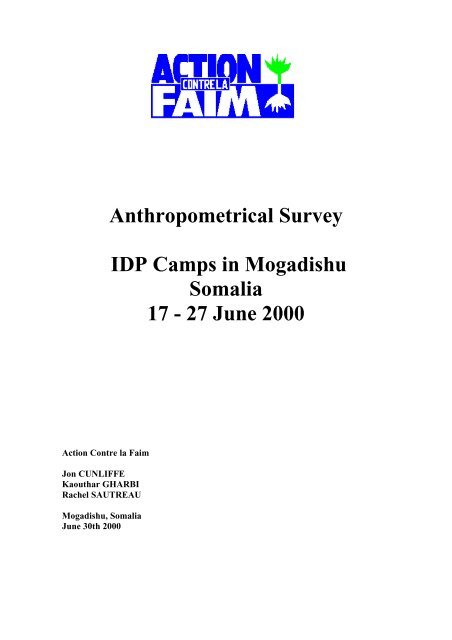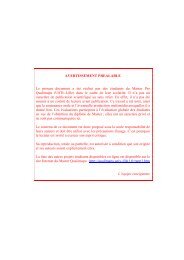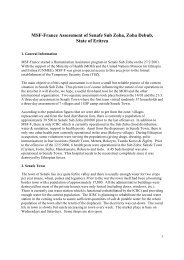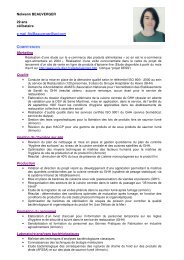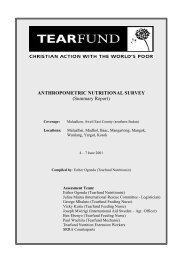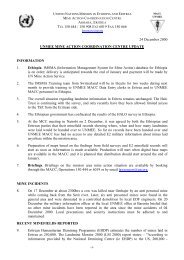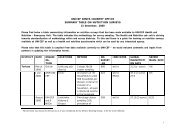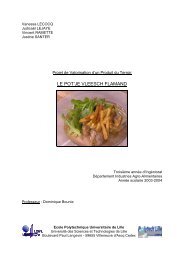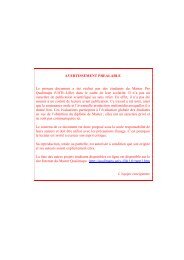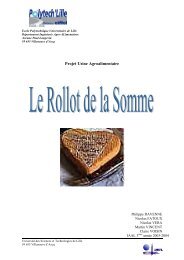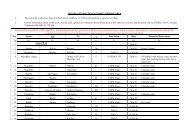IDPs (ACF) - PFEDA / Page d'accueil PFEDA
IDPs (ACF) - PFEDA / Page d'accueil PFEDA
IDPs (ACF) - PFEDA / Page d'accueil PFEDA
Create successful ePaper yourself
Turn your PDF publications into a flip-book with our unique Google optimized e-Paper software.
Action Contre la Faim<br />
Jon CUNLIFFE<br />
Kaouthar GHARBI<br />
Rachel SAUTREAU<br />
Mogadishu, Somalia<br />
June 30th 2000<br />
Anthropometrical Survey<br />
IDP Camps in Mogadishu<br />
Somalia<br />
17 - 27 June 2000
CONTENTS<br />
<strong>Page</strong> 3: Acknowledgements<br />
<strong>Page</strong> 4 – 6: Summary<br />
<strong>Page</strong> 7 – 8: Introduction<br />
<strong>Page</strong> 9: Objectives<br />
<strong>Page</strong> 10 - 11: Methodology<br />
<strong>Page</strong> 12 - 13: Data Collection<br />
<strong>Page</strong> 14: Indicators and Guidelines Used<br />
<strong>Page</strong> 15 - 24: Results<br />
<strong>Page</strong> 25 – 27: Discussion<br />
<strong>Page</strong> 28: Recommendations<br />
ANNEX 1: Map of Mogadishu (available only with printed version).<br />
ANNEX 2: Background Statistics and Information on Mogadishu (from <strong>ACF</strong>)<br />
ANNEX 3: List of population and names of all IDP camps in Mogadishu<br />
ANNEX 4: IDP camps used for cluster selection in the Nutritional Survey<br />
ANNEX 5: Schedule and selected clusters<br />
ANNEX 6: Explanation of Normalisation Tests<br />
ANNEX 7: Forms and Charts used in the Nutritional Survey<br />
ANNEX 8: Events Calendar<br />
ANNEX 9: Results of the previous Nutritional Surveys conducted by <strong>ACF</strong><br />
since 1994<br />
ANNEX 10: Collection of Mortality Statistics for the Survey<br />
2
ACKNOWLEDGEMENTS<br />
The Action Contre la Faim (<strong>ACF</strong>) Nutrition team would like to offer thanks to the<br />
following people for assisting them, and without whom this survey would not have been<br />
possible:<br />
- <strong>ACF</strong> Mogadishu Logistics and Security Teams<br />
- <strong>ACF</strong> Health Education Team<br />
- <strong>ACF</strong> Paris Nutrition Staff<br />
- European Community Humanitarian Office (ECHO)<br />
As usual <strong>ACF</strong> would like to thank, above all, the staff that have worked on the survey<br />
and the Internally Displaced People (<strong>IDPs</strong>) in Mogadishu who welcomed us and assisted<br />
us in performing this survey – in particular the Chairmen of the camps.<br />
3
OBJECTIVES<br />
SUMMARY<br />
• To quantify malnutrition rates in children aged between 6 and 59 months in the IDP<br />
(Internally Displaced Peoples Camps) in Mogadishu, Somalia.<br />
• To quantify the measles vaccination coverage in the IDP camps<br />
• To assess Therapeutic Feeding Centre coverage<br />
• To assess the period of time that <strong>IDPs</strong> have been in Mogadishu.<br />
• To quantify the mortality rate in the IDP camps, and the causes of mortality.<br />
• To assess the use of latrines and the amount of water used per person per day<br />
METHODOLOGY<br />
This survey was carried out in the IDP camps accessible to <strong>ACF</strong> in Mogadishu between<br />
the 17 th and 30 th of June 2000.<br />
Classic double cluster anthropometrics survey technique was employed (30 clusters of 30<br />
children – total 900 children surveyed).<br />
Only children aged between 6 and 59 months were included in the survey<br />
MALNUTRITION RATE<br />
Global acute malnutrition and Severe Acute Malnutrition of children from 6 – 59 months<br />
Expressed in z-scores (-2 z-scores<br />
for Global, -3 z-scores for<br />
Severe) and including bilateral<br />
oedema<br />
Expressed as a % of the Median<br />
(between 70 and 80% for Global,<br />
FEEDING CENTRE COVERAGE<br />
Feeding Centre coverage: 0 %<br />
PERIOD OF DISPLACEMENT:<br />
<strong>IDPs</strong> < 3 months<br />
<strong>IDPs</strong> 3 – 6 months<br />
<strong>IDPs</strong> 6 – 12 months<br />
<strong>IDPs</strong> greater than 1 year<br />
MORTALITY RATE<br />
Number and Percentage<br />
2 (0.2 %)<br />
6 (0.6 %)<br />
21 (2.1 %)<br />
992 (97.1 %)<br />
Mortality Rate of Children under five years: 7.08 / 10 000 / day<br />
Causes of Mortality: Diarrhoea: 55.6%<br />
Measles: 2.5%<br />
ARI: 6.2%<br />
Malaria: 2.5%<br />
Others / Unknown: 28.4%<br />
Mortality Rate of Adults: 0.67 / 10 000 / day<br />
Causes of Mortality: Diarrhoea: 65.5%<br />
Measles: 0%<br />
ARI: 0%<br />
Malaria: 0%<br />
Others / Unknown: 34.5 %<br />
USE OF LATRINES / AVERAGE QUANTITY OF WATER USED PER FAMILY:<br />
<strong>IDPs</strong> using latrines: 90%<br />
Mean quantity of water used per person per day: 12.46 Litres<br />
5
RECOMMENDATIONS<br />
• An evaluation into the effective area of coverage of the 4 TFCs in the city would assist<br />
in defining the future need for 4 TFCs in the city given the comparatively low rate of<br />
malnutrition found.<br />
• Active case finding and screening should be increased to ensure the early reference of<br />
the severely malnourished to the TFC.<br />
• At a minimum, a further nutritional survey should be undertaken on the same<br />
population in November 2000 – before the next Cholera outbreak. In addition, it<br />
would be useful to perform a survey on the Resident population of the town if at all<br />
possible.<br />
• Access to, knowledge of, and the quantity of free simple medical assistance (Health<br />
Posts, ORS points etc.) needs to be increased.<br />
• Evaluate, strongly supervise and if necessary re-orientate Health Education Activities.<br />
• Increase supervision of Vaccination activities.<br />
• Perform regular statistically viable surveys of the vaccination coverage and mortality<br />
on a two monthly basis.<br />
• Improve supervision of Health Education activities and evaluate the impact of the<br />
Health Education given.<br />
• The system of the collection of information about the movements of population into<br />
the city of Mogadishu should be reviewed.<br />
• The use of the 125mm cut-off point with the muac to indicate Global Acute<br />
Malnutrition should be studied further in a maximum of Anthropometrical Nutrition<br />
Surveys.<br />
6
INTRODUCTION<br />
Mogadishu needs little introduction. Since the collapse of the Somali State in 1991, and<br />
the withdrawal of the United Nations forces in 1995 Mogadishu has been in a state of<br />
anarchy and chaos. The town is effectively split into 2, with the North and South<br />
separately controlled. In addition there is an enclave called Medina in the Southern<br />
controlled area. A map of Mogadishu is enclosed as Annex 1. Since this time there has<br />
been a steady decrease in the presence of Humanitarian Organisations in Mogadishu. At<br />
the time of writing, <strong>ACF</strong> is the only Humanitarian Organisation left in Mogadishu with a<br />
permanent Expatriate presence in both the North and the South of Mogadishu.<br />
<strong>ACF</strong> has been operating in Somalia since 1990. The present programme in Mogadishu<br />
includes 4 Therapeutic Feeding Centres (TFCs) in the city – at Medina, Towfiq, Hodan<br />
and Forlanini (in the North). In addition there is an ongoing Water and Sanitation<br />
Programme that works in the IDP camps around the city on latrine construction, and the<br />
chlorination of wells. <strong>ACF</strong> also has an Expanded Programme of Immunization (EPI)<br />
team working in the IDP camps in the South of Mogadishu. Finally, Health Education<br />
teams are active both in the South and the North in the IDP camps.<br />
This Nutritional Survey is the first statistically relevant anthropometric nutritional survey<br />
to be conducted in Mogadishu since 1995. It is hoped that the results of this Nutritional<br />
Survey will help provide some ideas about the impact of some of the programmes that<br />
Agencies have been running since that time, and suggest ways of developing projects in<br />
the future.<br />
The survey took place between the 17 th and 27 th of June 2000 in the Internally Displaced<br />
People (IDP) camps accessible to Action Contre la Faim (<strong>ACF</strong>) in and around both North<br />
and South Mogadishu. These IDP camps represent around 57% of the total population of<br />
<strong>IDPs</strong> in Mogadishu.<br />
An obvious result of the lack of Humanitarian Presence in Mogadishu, is that it proved to<br />
be difficult to find background information about the current Humanitarian situation of<br />
the <strong>IDPs</strong> in Mogadishu. The following agencies (amongst others) were contacted by <strong>ACF</strong><br />
prior to this survey in order to obtain further background information about Mogadishu:<br />
- Food Security Alert Unit (FSAU)<br />
- United Nation Co-ordination Unit (UNCU)<br />
- Food and Agricultural Office (FAO)<br />
- United Nations World Food Programme (UNWFP)<br />
- Save the Children Fund United Kingdom (SCF/UK)<br />
In addition, over the last few years <strong>ACF</strong> has collated some information on Mogadishu.<br />
This information includes information on TFC attendance, the numbers of reported<br />
Influxes and Outflows from the IDP camps, and the presence of contagious diseases in<br />
the IDP camps visited by the <strong>ACF</strong> Health Educators. This information has been used to<br />
7
help in the interpretation of results of the Nutritional Survey and has been included in<br />
Annex 2.<br />
The Nutritional Survey took place at the time when the 1 st rainy season was in process<br />
(the ‘Gu’ season). This year the rains have arrived in Mogadishu, as in everywhere else in<br />
the country. As the population of Mogadishu has become increasingly reliant on<br />
agricultural activities, this may have some significance in the survey results, as it<br />
correlates with a time of a traditional ‘Hunger Gap’ – i.e. the period prior to harvesting.<br />
Market prices of sorghum and maize, stable parts of the diet of the population, have<br />
increased during the period prior to the Nutritional Survey by around 3%. This first half<br />
of the year (January – June), is in addition, corresponding with the period of time when<br />
there is the majority of the admissions into the <strong>ACF</strong> TFCs (see Annex 2).<br />
The Cholera outbreak was just starting to tail off during the Nutritional Survey. This<br />
assumption corresponded with both the traditional period for the end of the Cholera<br />
outbreak, and the statistics for the Cholera Treatment Centres in the town (all of which<br />
were reducing).<br />
Although its extremely difficult to say with any certainty, a hypothesis could be made<br />
that the IDP population is likely to be more vulnerable than the normal resident<br />
population of the town of Mogadishu. Their income generating activities are limited (See<br />
Annex 2 – for income generating activities of <strong>IDPs</strong> and how much each activity pays).<br />
What better possibilities for employment that there are in the city are generally taken by<br />
the resident population. (Ref: Broudic, C., 1997, Socio – Economic Context of the<br />
Vulnerable Population in Mogadishu, Nairobi, <strong>ACF</strong>).<br />
In <strong>ACF</strong>s 4 TFCs in Mogadishu, <strong>IDPs</strong> are twice as likely to frequent the TFCs as residents<br />
of Mogadishu (<strong>IDPs</strong> comprising approximately 20% of the population make up globally<br />
45% of the admissions in the 4 TFCs).<br />
The IDP population was consequently chosen as the target group for the <strong>ACF</strong> Nutrition<br />
survey for the following reasons:<br />
- Security and Access, the presence of <strong>ACF</strong> in these camps for an extended<br />
period of time meant that they were considered safe to visit.<br />
- Overall, this group was considered to represent a part of the population that<br />
was likely to be affected by malnutrition.<br />
Population figures for Mogadishu vary considerably depending with who they are<br />
discussed. <strong>ACF</strong> based its population figures on available information from the Elders, the<br />
<strong>ACF</strong> Water and Sanitation team, and, the <strong>ACF</strong> Health Education team. The IDP<br />
population of Mogadishu has built up considerably over the last 10 years. Their reasons<br />
for displacement are varied, but drought, famine and war have all had an important part<br />
to play in the last few years.<br />
It was estimated that 237,000 people live in the IDP camps in and around Mogadishu;<br />
approximately 135,000 of them (57% of the IDP population) were included in the survey.<br />
8
OBJECTIVES<br />
• To quantify malnutrition rates in children aged between 6 and 59 months in the IDP<br />
(Internally Displaced Peoples Camps) in Mogadishu, Somalia.<br />
• To quantify the measles vaccination coverage in the IDP camps<br />
• To assess Therapeutic Feeding Centre coverage<br />
• To assess the period of time that <strong>IDPs</strong> have been in Mogadishu.<br />
• To quantify the mortality rate in the IDP camps, and the causes of mortality.<br />
• To assess the use of latrines and the amount of water used per person per day<br />
9
METHODOLOGY<br />
The target population for the survey was children aged between 6 and 59 months. This<br />
age group is considered to be particularly vulnerable to malnutrition.<br />
1. Survey Design<br />
Classic two-stage cluster sampling was used for the survey. A total of 30 clusters of 30<br />
children aged 6 to 59 months old were selected in order to provide an estimate of the<br />
prevalence of malnutrition with a minimum 5% confidence.<br />
2. Sampling methodology<br />
Initially a sampling framework was constructed from which a representative sample<br />
could be drawn from. Population figures were collected from a variety of sources (<strong>ACF</strong><br />
Water and Sanitation Team, <strong>ACF</strong> Health Education Team Statistics and IDP camp<br />
Elders). Only camps that were accessible to <strong>ACF</strong> were included in the sampling<br />
framework. Annexes 3 and 4 details those camps the camps and their populations that<br />
were included in the survey as well as those that could not be included.<br />
The percentage of children less than 5 years was then estimated at 20% and the<br />
cumulative target population determined. For each section of the town the estimated<br />
population, and the estimated number of children under 5 was then listed. The cumulative<br />
population of children under 5 years old was then calculated by adding at each stage of<br />
the list the number of children under 5 years to the total of the number of children under 5<br />
years in the previous section(s) of the town.<br />
Thirty clusters were randomly selected. The cluster interval was calculated by dividing<br />
the total cumulative population under five years old by the number of clusters: (22962 /<br />
30 = 765). A random number was then chosen between one and the cluster interval using<br />
a random number table to have a starting number (51) for the first cluster. The following<br />
29 clusters were selected systematically by adding the cluster interval number to the<br />
previous cluster. Details can be found in Annex 5.<br />
Once this list had been completed, the <strong>ACF</strong> Health Education team visited each chosen<br />
cluster prior to the day of the survey to inform the people about the survey, the purpose of<br />
the survey, and to ask that the population of the cluster stay at home on the day of the<br />
survey.<br />
The second stage of sampling was carried out in the cluster. In general, one member of<br />
the team went to the centre of the chosen area with the chief of the community and threw<br />
a pencil to determine a direction and all the households following this direction were<br />
visited and all the children found in the houses between 6 and 59 months, and between 65<br />
and 110 cm, were screened. However, due to the nature of the IDP camps in Mogadishu<br />
10
this was not always possible, and alternative methods of selecting the second stage of the<br />
sampling had to be used.<br />
Some of the clusters were buildings, with the whole cluster split between the three or 4<br />
different floors of the building, the roof of the building, and the area outside of the<br />
building. In this case, all these areas were given a number. A random number was then<br />
drawn and the area that had the same allocated number as the random number was used<br />
for the sample, and then the second stage of sampling was carried out in this area (as<br />
described above). If the area was exhausted of children before the required 30 had been<br />
reached, a further area was randomly selected.<br />
In other clusters the choice of direction was limited to 2, as the cluster stretched, for<br />
example, along the side of a road.<br />
If a child was absent, contrary to standard Nutritional Survey techniques, the team did not<br />
make an appointment to come back and see the child. This was because of the security<br />
constraint of limited movement and time on the ground to a minimum. However, if the<br />
child was in the hospital or Therapeutic Feeding Centre the team visited the child there<br />
and recorded his measurements – but only if this structure was accessible for <strong>ACF</strong><br />
Expatriate supervised teams. If the limit of the section was reached before completing the<br />
cluster, the team returned back to the centre of the cluster and the second stage of<br />
sampling was started again.<br />
In the event that insufficient children were found in the selected camp, the nearest camp<br />
to the selected camp was visited and the outstanding number of children surveyed from<br />
this site using the same methodology as outlined above.<br />
3 teams were used to collect the survey data. Each team comprised of a qualified <strong>ACF</strong><br />
Expatriate Nurse Nutritionist for the supervision, a Registrar to record the details and ask<br />
the supplementary questions, and 2 Measurers to take the anthropometric measurements.<br />
A week of training prior to the survey was completed with the teams. This training was<br />
focussed on the correct taking of anthropometric measurements. In the last 3 days,<br />
Normalisation tests were completed with the staff to ensure an optimal precision was<br />
obtained. (Annex 6 details how these tests are undertaken and how the results are<br />
interpreted).<br />
11
Data Collection<br />
The forms used to collect the information are included as Annex 7.<br />
Age: was recorded with the help of a local calendar of events (see Annex 8). Only<br />
children between the ages of 6-59 months were included in the survey. If the age could<br />
not be ascertained only the children between 65 and 110 cm were included in the survey.<br />
Weight: Children were weighed without clothes using a 25 kg Salter scale (precision of<br />
100g).<br />
Height: Each child was measured using a height board (precision of 0.1 cm). Children<br />
less than 85 cm in height had to be measured lying down. Children equal to or more than<br />
85 cm were measured standing up.<br />
Mid upper arm circumference (MUAC): This was measured to the nearest 0.1cm. The<br />
MUAC was measured at the mid point of the left upper arm.<br />
Oedema: Only children with bilateral oedema on the lower limbs were recorded as<br />
having nutritional oedema.<br />
Mortality: This was taken retrospectively. Each family was asked the composition of<br />
their family in two parts – those family members less than 5 years, and those family<br />
members more than 5 years. The family was then asked how many people had died in the<br />
last three months – for both the under 5 years of age, and those over 5 years. The 3-month<br />
period was easy to define because ‘Atha’ (an important religious event) had finished<br />
almost exactly 3 months ago on the 16 th March 2000.<br />
If the family was without a child of less than 5 years, even though no anthropometric<br />
information could be obtained, the family was still asked if they had had a child who had<br />
died during the last 3 months and this information was collected.<br />
The overall mortality was calculated by taking the total number of dead and multiplying<br />
this figure by 10,000. This figure was then divided by the total population 3 months<br />
previously. Finally it was divided again by 98. Ninety-eight represented the average<br />
number of days from ‘Atha’ to the survey. As the survey took place over a relatively<br />
long period of time (9 days - due to the security constraints), the number of days between<br />
‘Atha’ and the 5 th day of the survey was calculated (98).<br />
If a family said that their child had died, the team asked the family to explain what the<br />
signs and symptoms were of the child’s illness before he/she died. The team then<br />
compared this information with the simple case definitions below.<br />
Diarrhoea: More than 3 liquid stools per day.<br />
Measles: Spots, Fever, Mouth Infection, Chest Infection, Eye Infection (more than 3<br />
signs considered enough to identify the cause as Measles).<br />
12
ARI: (Acute Respiratory Infection). Cough, Shortness of Breath, Fever<br />
Malaria: High Fever, Coma<br />
Malnutrition: Anorexia, loss of weight, oedema<br />
Others: All other causes<br />
Measles vaccinations: For all children from 9 to 59 months the mothers were asked for<br />
vaccination cards. The vaccination card was then checked. If no vaccination card was<br />
available, the mothers were asked if their child had been immunised against measles.<br />
Length of time in Mogadishu: The 4 periods of time that were used fitted in with<br />
significant local events to enable the team to say accurately how long the families had<br />
been displaced for. The 4 periods of time considered were up to 3 months (this correlated<br />
with the time from ‘Atha’ to the day of the survey, 3 – 6 months (this correlated with the<br />
period of time between ‘Atha’ and the end of ‘Ramadan’), 6 – 12 months (this correlated<br />
with the period of time between ‘Ramadan’ and ‘Mawlid’) and greater than 12 months<br />
(this correlated with the period of time after ‘Mawlid’).<br />
Frequentation of the <strong>ACF</strong> Therapeutic Feeding Centre: Those children who were<br />
found in the criteria of severe malnutrition were considered not to frequent the <strong>ACF</strong><br />
Therapeutic Feeding Centre. Only when a child was not be found at home and was found<br />
instead at the TFC and was still in the criteria of severe malnutrition was he considered to<br />
frequent the centre.<br />
Latrine Use: Families were simply asked whether they used a latrine or not.<br />
Water Consumption: The quantity of water per day used by the entire family was<br />
estimated by families and recorded. As the number of people in the family was recorded<br />
in the mortality data, it was possible to work out the average personal consumption.<br />
13
Indicators and guidelines used<br />
Acute malnutrition rates were estimated from the weight for height index values. Weight<br />
for height index was calculated using National Centre for Health Statistics as a reference.<br />
This is considered the most appropriate index to quantify wasting in a population in<br />
emergency situations where acute forms of malnutrition are the predominant pattern. The<br />
expression in Z-scores has a true statistical meaning and allows inter-study comparison.<br />
The percentage of the median is commonly used to identify eligible children for feeding<br />
programmes.<br />
Guidelines for the results expressed in Z-Score:<br />
• Severe acute malnutrition is defined by W/H < -3 SD and/or oedema<br />
• Global acute malnutrition is defined by W/H < -2 SD and/or oedema<br />
Guidelines for the results expressed in percentage of the reference median:<br />
• Severe acute malnutrition is defined by W/H < 70 % and/or oedema<br />
• Global acute malnutrition is defined by W/H < 80 % and/or oedema<br />
Mid Upper Arm Circumference (MUAC) is a useful tool for rapid screening of children<br />
at a higher risk of mortality. MUAC changes only marginally between 12 and 59 months<br />
of age (75 to 110 cm height group) and therefore does not need to be related to the age. It<br />
is a reliable indicator of the muscular status of the child and is mainly used to identify<br />
children with a high risk of mortality. The cut off values can vary according to authors;<br />
the following figures were used for this survey:<br />
• Low risk of mortality: MUAC ≥ 120mm<br />
• Moderate risk of mortality: 110 mm ≤ MUAC < 120 mm:<br />
• Severe risk of mortality: MUAC < 110 mm<br />
Admission and discharge criteria in Action Contre la Faim feeding centres:<br />
Therapeutic Feeding W/H < 70% of the median<br />
and /or bilateral oedema<br />
and /or Muac < 11 cm for height ≥75 cm<br />
Supplementary Feeding W/H < 80% of the median<br />
and /or 11 85% for 2 consecutive weighing<br />
Absence of bilateral oedema 15 days<br />
MUAC > 12 cm<br />
Ascending weight curve<br />
W/H > 85% for 2 consecutive weighing<br />
MUAC > 12 cm<br />
Ascending weight curve
RESULTS<br />
The data processing and analysis were carried out using the programme EPI-INFO 5.0.<br />
The calculation and the analysis of the anthropometrical indications were carried out<br />
using the EPINUT programme. All children between 6 and 59 months were recorded and<br />
analysed.<br />
1. Distribution by age and sex<br />
TABLE 1: DISTRIBUTION BY AGE AND BY SEX<br />
AGE CLASS BOYS GIRLS | TOTAL SEX RATIO<br />
N % N % | N %<br />
___________________________________________|______________________<br />
06-17 124 54.6% 103 45.4% | 227 25.2% 1.20<br />
18-29 154 58.6% 109 41.4% | 263 29.2% 1.41<br />
30-41 105 57.1% 79 42.9% | 184 20.4% 1.33<br />
42-53 95 52.8% 85 47.2% | 180 20.0% 1.12<br />
54-59 22 47.8% 24 52.2% | 46 5.1% 0.92<br />
___________________________________________|______________________<br />
TOTAL 500 55.6% 400 44.4% | 900 100.0% 1.25<br />
The results show that there were a higher number of boys than girls included in the<br />
survey. For every 5 boys sampled, only 4 girls were surveyed.<br />
2. Nutritional status<br />
The global acute malnutrition rate expressed as a Z-Score was 12.9% (95% Confidence<br />
Interval (CI: 10.0 – 16.5 %), including 2.0 % of severe malnutrition (CI: 1.0 – 3.9 %).<br />
Expressed as a percentage of the median, the overall global acute malnutrition rate was<br />
9.0 % (CI: 6.5 – 12.2 %), including 1.6 % (CI: 0.7 – 3.3 %) of severe malnutrition.<br />
Z-SCORE 2.0 %<br />
(1.0 – 3.9 %)<br />
% OF MEDIAN 1.6 %<br />
(0.7 – 3.3 %)<br />
SEVERE GLOBAL<br />
15<br />
12.9 %<br />
(10.0 – 16.5 %)<br />
9.0 %<br />
(6.5 – 12.2 %)<br />
Among the severely malnourished 6 cases of Oedema were found during the survey.
Weight for height index distribution<br />
F<br />
r<br />
e<br />
q<br />
u<br />
e<br />
n<br />
c<br />
y<br />
30<br />
25<br />
20<br />
15<br />
10<br />
5<br />
0<br />
-4.75<br />
-3.75<br />
-2.25<br />
-0.75<br />
0.75<br />
2.25<br />
3.75<br />
Z-SCORE<br />
The distribution of weight for height index expressed in Z-score, in comparison to the<br />
reference curve, appears to the left of that of the reference population. This shows that the<br />
nutritional status of the children in the displaced camps is lower than that of the reference<br />
population. The mean weight for height index expressed as Z-score is -0,99 with a<br />
standard deviation of 0,90.<br />
16<br />
5<br />
Reference<br />
Sex Combined
Height for Age Distribution Curve<br />
F<br />
R<br />
E<br />
Q<br />
U<br />
E<br />
N<br />
C<br />
Y<br />
25<br />
20<br />
15<br />
10<br />
5<br />
0<br />
-4.75<br />
-3.75<br />
-2.25<br />
-0.75<br />
0.75<br />
Z-SCORE<br />
The distribution of height for age index expressed in Z-score, in comparison to the<br />
reference curve, appears to the left of that of the reference population. This shows that the<br />
long-term nutritional status of the children in the displaced camps is lower than that of<br />
the reference population. The mean height for age index expressed as Z-score is –1.71<br />
with a standard deviation of 1.28.<br />
3. Anthropometric analysis<br />
2.25<br />
3.75<br />
3.1 Distribution in Weight for Height Z-scores<br />
TABLE 2: WEIGHT/HEIGHT: DISTRIBUTION BY GROUP OF AGE IN Z SCORES<br />
=-3&=-2 STD OEDEMA<br />
N n % n % n % n %<br />
___________________________________________________________<br />
06-17 227 6 2.6% 23 10.1% 196 86.3% 2 0.9%<br />
18-29 263 4 1.5% 35 13.3% 222 84.4% 2 0.8%<br />
30-41 184 1 0.5% 23 12.5% 159 86.4% 1 0.5%<br />
42-53 180 1 0.6% 14 7.8% 164 91.1% 1 0.6%<br />
54-59 46 0 0.0% 3 6.5% 43 93.5% 0 0.0%<br />
___________________________________________________________<br />
TOTAL 900 12 1.3% 98 10.9% 784 87.1% 6 0.7%<br />
17<br />
5<br />
Reference<br />
Sex Combined
TABLE 3: WEIGHT/HEIGHT: DISTRIBUTION BY HEIGHT IN Z SCORES<br />
Global acute malnutrition<br />
Severe acute malnutrition<br />
Total children Children < 80 cm<br />
n=900 n=400<br />
12,9 %<br />
(CI: 10.9%-16.5%)<br />
2,0 %<br />
(CI: 1.0%-3.9%)<br />
18<br />
16,0 %<br />
(CI: 11.3%-22.2%)<br />
3,3 %<br />
(1,3%-7,1%)<br />
TABLE 4: WEIGHT/ HEIGHT: DISTRIBUTION BY AGE IN Z SCORES<br />
Global acute malnutrition<br />
Severe acute malnutrition<br />
6-59 months 6 - 29 months<br />
n=900 n=400<br />
12,9 %<br />
(CI: 10.9%-16.5%)<br />
2,0 %<br />
(CI: 1.0%-3.9%)<br />
14,7 %<br />
(CI: 10.6%-20.0%)<br />
2.9 %<br />
(1,2%-6.1%)<br />
In tables 2, 3 and 4 it can be seen that younger children are more prone to both Global<br />
Acute Malnutrition and Severe Acute Malnutrition. The comparison was made using both<br />
the height and the age of the children. A height of less than 80cm usually implies an age<br />
of less than 2 years.<br />
TABLE 5: WEIGHT/HEIGHT INDEX VS. OEDEMA (Z SCORES)<br />
OEDEMA<br />
-2Z<br />
MARASM/KWASH KWASHIORKOR<br />
YES 3 0.3% 3 0.3%<br />
MARASMUS NORMAL<br />
NO 110 12.2% 784 87.1%
4.2 Distribution in % of the Median<br />
TABLE 6: MALNUTRITION BY AGE EXPRESSED AS % OF MEDIAN<br />
=70%&=80% OEDEMA<br />
N n % n % n % n %<br />
____________________________________________________________________<br />
06-17 227 2 0.9% 19 8.4% 204 89.9% 2 0.9%<br />
18-29 263 4 1.5% 24 9.1% 233 88.6% 2 0.8%<br />
30-41 184 1 0.5% 17 9.2% 165 89.7% 1 0.5%<br />
42-53 180 1 0.6% 6 3.3% 172 95.6% 1 0.6%<br />
54-59 46 0 0.0% 1 2.2% 45 97.8% 0 0.0%<br />
____________________________________________________________________<br />
TOTAL 900 8 0.9% 67 7.4% 819 91.0% 6 0.7%<br />
TABLE 7: WEIGHT/HEIGHT: DISTRIBUTION BY GROUP OF AGE IN % OF<br />
MEDIAN<br />
Global acute malnutrition<br />
Severe acute malnutrition<br />
6-59 months 6 - 29 months<br />
n=900 n=400<br />
9.0 %<br />
(CI: 6.5%-12.2%)<br />
1.6 %<br />
(CI: 0.7%-3.3%)<br />
19<br />
10.8 %<br />
(CI: 7.3%-15.7%)<br />
2.0 %<br />
(0.7%-5,0%)<br />
TABLE 8: WEIGHT/HEIGHT INDEX vs. OEDEMA (% OF MEDIAN)<br />
80%<br />
MARASM/KWASH KWASHIORKOR<br />
YES 3 0.3% 3 0.3%<br />
OEDEMA<br />
MARASMUS NORMAL<br />
NO 75 8.3% 819 91.0%
4.3 Distribution of brachial circumference (MUAC)<br />
4.3.1 MUAC vs. Height<br />
The MUAC distribution versus the height among the target population is shown below.<br />
The following cut-off points for the height are used: 75 cm as an average for a 1 year old<br />
child, 90 cm for children of 3 years old, and 110 cm for children of 5 years old.<br />
TABLE 9: MUAC VERSUS HEIGHT<br />
MUAC
WHZ < -3 Z<br />
STD<br />
-3STD
Children should be considered as vaccinated only when a card proves that the vaccination<br />
has been given. Unverified information from the mother stating that her child has had<br />
measles cannot be confirmed and therefore cannot be considered as statistically<br />
significant information. When the unverified information of the mother is taken into<br />
account the total is 73.4% of the children vaccinated.<br />
6. Coverage of Nutrition Programmes<br />
The coverage of Feeding Centre programmes is estimated through comparing the number<br />
of severe malnourished children in Therapeutic Feeding programmes the day of the<br />
survey with the number of children found with severe acute malnutrition found in the<br />
survey, according to the <strong>ACF</strong> criteria (i.e. admission in feeding centre W/H < 70% of the<br />
median and/or oedema and/or MUAC
8. Mortality rate and Causes of Mortality<br />
The overall mortality was calculated by taking the total number of dead and multiplying<br />
this figure by 10,000. This figure was then divided by the total population 3 months<br />
previously. Finally it was divided again by 98. Ninety-eight represented the average<br />
number of days from ‘Atha’ to the survey. As the survey took place over a relatively<br />
long period of time (9 days - due to the security constraints), the number of days between<br />
‘Atha’ and the 5 th day of the survey was calculated (98).<br />
The total number of recorded deaths over the last 98 days was 81 for the children underfive<br />
years of age, and 29 for the population over five years of age (see Annex 10).<br />
The mortality rate for under-five children was calculated as being 7.08 / 10,000/ day in<br />
the <strong>IDPs</strong> camps. This rate is very high, as a rate of more than 1 / 10,000 / day is<br />
considered above the norm. The reasons for mortality are cited below:<br />
CAUSE NUMBER % OF TOTAL DEATHS<br />
DIARRHOEA 45 55.6<br />
MEASLES 2 2.5<br />
ARI 5 6.2<br />
MALARIA 2 2.5<br />
MALNUTRITION 4 4.9<br />
OTHER 23 28.4<br />
TOTAL 81 100<br />
The mortality rate for the population over 5 years of age was calculated as being 0.67 /<br />
10,000 / day in the <strong>IDPs</strong> camps. This rate is high for a population above 5 years of age.<br />
The reasons for mortality are cited below:<br />
CAUSE NUMBER % OF TOTAL DEATHS<br />
DIARRHOEA 45 65.5<br />
MEASLES 2 0<br />
ARI 5 0<br />
MALARIA 2 0<br />
MALNUTRITION 4 0<br />
OTHER 23 34.5<br />
TOTAL 81 100<br />
Note that in both cases Diarrhoea is the most important cause of mortality and represents<br />
well over half of all the recorded deaths.<br />
23
9. Use of latrines and average quantity of water used per person per day.<br />
For the latrine usage, families were simply asked whether or not they used latrines, and a<br />
simple ‘yes’ or ‘no’ answer recorded.<br />
No of sampled people using latrine: 919 (90%)<br />
The average quantity of water used per person was calculated by asking the family for the<br />
total quantity of water they used and dividing it by the number of people in the family:<br />
Average quantity of water used per person per day: 12.46 Litres<br />
24
Anthropometrical Results<br />
DISCUSSION<br />
The Nutritional Survey results would indicate that the nutritional situation amongst the<br />
<strong>IDPs</strong> in Mogadishu is still poor – although not catastrophic. At the same time additional<br />
information collected in the survey indicates an extremely high rate of mortality amongst<br />
young children. The two pieces of information could in fact be complimentary. Children<br />
who are malnourished have a higher risk of mortality – having less resistance to<br />
infections and a poorer ability to cope with them when they do catch them.<br />
Younger children (i.e. those between 65cm and 80cm or those between 6 and 29 months)<br />
appear to be more at risk of severe malnutrition than older children. One possible<br />
explanation for this is that a lack of health education has meant that parents have poor<br />
breastfeeding and weaning habits, making these children particularly vulnerable. A<br />
further possibility is that these children are generally physiologically more vulnerable to<br />
infections and illnesses than older children. One likely consequence of these infections is<br />
a drop in Nutritional Status – more energy being required to fight the infections coupled<br />
with a potential loss of appetite.<br />
It proved to be difficult even with the assistance of an Events Calendar and strong<br />
Expatriate supervision to gain truly valid information about the age of the children in<br />
certain cases. However, even given this difficulty the Height for Age distribution curve<br />
would indicate that stunting is a significant problem. This could be expected, given the<br />
context of civil war and the breakdown of central authority that the <strong>IDPs</strong> have been living<br />
in for the last 5 years.<br />
As usual there is a difference in the rate of malnutrition when a comparison is made<br />
between the Z score results and the % of the Median results. However in both cases the<br />
situation is poor.<br />
Although no statistical comparison can be made between clusters, it was observed that<br />
malnutrition appeared to not be universal in the IDP camps. Camps in South Mogadishu<br />
appear to be in a worse state than those in the North.<br />
The IDP camps sampled are those where <strong>ACF</strong> has access – for referral to Therapeutic<br />
Feeding Centres, for Health Education sessions, and for Water and Sanitation work.<br />
Some other camps are being accessed by other agencies. But globally, it would be fair to<br />
say that the camps that were sampled are generally better supported than other camps<br />
around the city. Consequently, there is a high probability that the situation in those camps<br />
not sampled by <strong>ACF</strong> is worse than that outlined above.<br />
The hypothesis has been put forward that the population of the IDP camps surveyed was<br />
one of the groups of the overall Mogadishu population that was considered the most<br />
25
vulnerable to malnutrition. It would be interesting to pursue this theory further in the<br />
future by performing a further Nutritional Survey on the town population of Mogadishu.<br />
The last major Nutritional Survey to cover the <strong>IDPs</strong> (see Annex 10) was completed<br />
almost exactly 5 years ago between the 7 th and 20 th June 1995 (performed by <strong>ACF</strong>). The<br />
Global Acute Malnutrition rate (in Z scores) was 26.3% (CI: 22.3% - 30.8%). The Severe<br />
Acute Malnutrition rate (in Z scores) was 5.4% (CI: 3.5% - 8.1%). Although there has<br />
been a significant drop since this time (13.4% drop in Global Acute Malnutrition and<br />
3.4% in Severe Acute Malnutrition), there still remains a considerable problem.<br />
There is agreement between different agencies working in Somalia (Nutrition Working<br />
Group, 1999, ‘Nutrition Survey – Recommendations for Somalia’, Nairobi) that a MUAC<br />
of less than 125mm is equivalent to Global Acute Malnutrition. In this Nutrition Survey<br />
145 children (16.1%) were found with a MUAC of less than 125mm. Only 62 (42%) of<br />
these 145 children had in addition a corresponding weight for height score of less than 2<br />
Z scores. It would appear that using the MUAC of less than 125mm as a criterion of<br />
Global Acute Malnutrition is:<br />
- In this sample raising the overall Global Acute Malnutrition Rate by 24.8%<br />
- Corresponds on an individual basis with the Statistically correct Z scores only<br />
42% of the time.<br />
Vaccination Coverage<br />
The correct vaccination coverage for measles is low. This is the normal situation at the<br />
moment in Somalia. Yet at the same time, the coverage appears to be particularly when<br />
account is take of the fact that <strong>ACF</strong> have been conducting an ongoing measles<br />
vaccination campaign (see Annex 2) which would indicate a far greater % of the<br />
population has been properly vaccinated than the survey indicates. It is interesting that a<br />
larger number of people said that there child had been vaccinated but were unable to<br />
produce the vaccination card. No firm explanation can be offered for this difference.<br />
5 years ago, in June 1995, the confirmed vaccination coverage for measles was 39.8%. It<br />
now stands at 10%. This is a massive reduction in confirmed coverage, and highlights the<br />
difficulties in undertaking vaccination activities in the context of Mogadishu. At the same<br />
time it has to be considered a weakness of the <strong>ACF</strong> vaccination team.<br />
Length of time displaced<br />
97.1% of the <strong>IDPs</strong> have now spent at least one year in Mogadishu. This does not<br />
correspond at all with the figures for the population influxes that <strong>ACF</strong> Health Education<br />
team collects each month (see Annex 2), which would indicate a much higher influx of<br />
new <strong>IDPs</strong> into the city over the last 12 months (around 10% of the population). The<br />
conflicting nature of these results would suggest that there is a need to review how this<br />
information is being collected on the ground.<br />
26
Mortality<br />
In global, the overall figure for mortality is extremely alarming. The fact that 55% of the<br />
mortality is due to Diarrhoea, and that latrine coverage is 90%, can only enhance this<br />
alarm. Some possible explanations, which could partially explain this, include the<br />
following:<br />
- The mortality was taken during the last three months, which corresponded<br />
with the peak in the Cholera outbreak and it is notable that Diarrhoea<br />
represents at least 55% of all the mortality. No attempt was made in the<br />
survey to differentiate between Common Diarrhoea and Cholera.<br />
- The overall impact of Health Education activities (many focussed on Hygiene<br />
and Diarrhoea) conducted in the IDP camps is probably less than anticipated.<br />
- A number of places in Mogadishu treat the main possible consequence of<br />
Diarrhoea (dehydration) freely. There would appear to be a lack of knowledge<br />
of their presence and purpose, or a potential problem of access to them, or<br />
finally not enough of them available to serve the needs of the population.<br />
- In Mogadishu it is generally accepted that the overall Sanitation situation in<br />
the town is poor. Improvements in not just the latrine coverage, but also the<br />
collection and disposal of rubbish, and the water distribution system would be<br />
needed to make a better impact on the Sanitation conditions. These actions<br />
together would probably diminish the number of cases of Diarrhoea. The<br />
impact of one action alone (latrine building) may not be enough.<br />
- Other diseases, such as malaria or measles, could be presenting a primary<br />
observed symptom of Diarrhoea.<br />
Given this high rate of mortality due to Diarrhoea, it would be useful to perform a further<br />
Nutritional survey after the end of the Cholera season to see if this figure changes. It<br />
would also be interesting to perform a further statistically relevant survey on mortality<br />
alone in the near future.<br />
Water and Sanitation<br />
Globally, the number of people claiming to use latrines is encouraging. Only 10% said<br />
that they did not use the toilets. The quantity of water used per person (12.46 litres) on<br />
average is slightly above the minimum acceptable international amount (10 litres).<br />
However, the team on the ground observed a grand difference between individual camps.<br />
Certain camps used as little as 5 litres per person, others up to 25 litres per person.<br />
This information above, although interesting, does not particularly reveal a lot about the<br />
Water and Sanitation situation in Mogadishu. However, it may assist in providing ideas<br />
for more focussed Water and Sanitation Surveys in the future.<br />
27
RECOMMENDATIONS<br />
• An evaluation into the effective area of coverage of the 4 TFCs in the city would assist<br />
in defining the future need for 4 TFCs in the city given the comparatively low rate of<br />
malnutrition found.<br />
• Active case finding and screening should be increased to ensure the early reference of<br />
the severely malnourished to the TFC.<br />
• At a minimum, a further nutritional survey should be undertaken on the same<br />
population in November 2000 – before the next Cholera outbreak. In addition, it<br />
would be useful to perform a survey on the Resident population of the town if at all<br />
possible.<br />
• Access to, knowledge of, and the quantity of free simple medical assistance (Health<br />
Posts, ORS points etc.) needs to be increased.<br />
• Evaluate, strongly supervise and if necessary re-orientate Health Education Activities.<br />
• Increase supervision of Vaccination activities.<br />
• Perform regular statistically viable surveys of the vaccination coverage and mortality<br />
on a two monthly basis.<br />
• Improve supervision of Health Education activities and evaluate the impact of the<br />
Health Education given.<br />
• The system of the collection of information about the movements of population into<br />
the city of Mogadishu should be reviewed.<br />
• The use of the 125mm cut – off point with the muac to indicate Global Acute<br />
Malnutrition should be studied further in a maximum of Anthropometrical Nutrition<br />
Surveys.<br />
28


